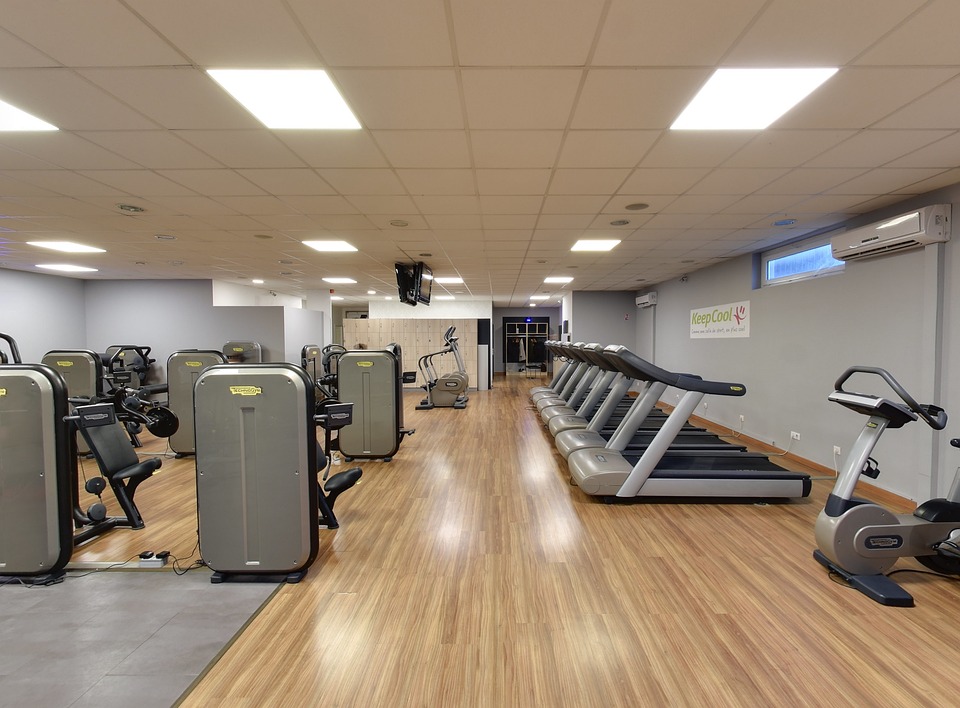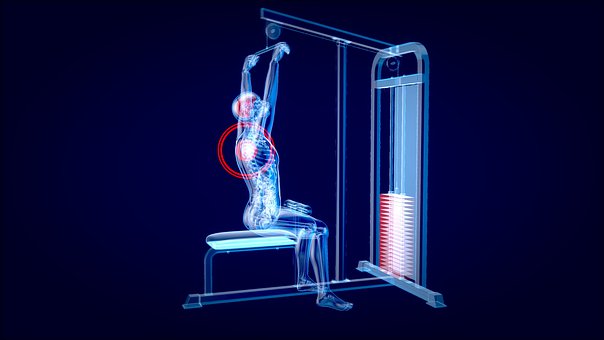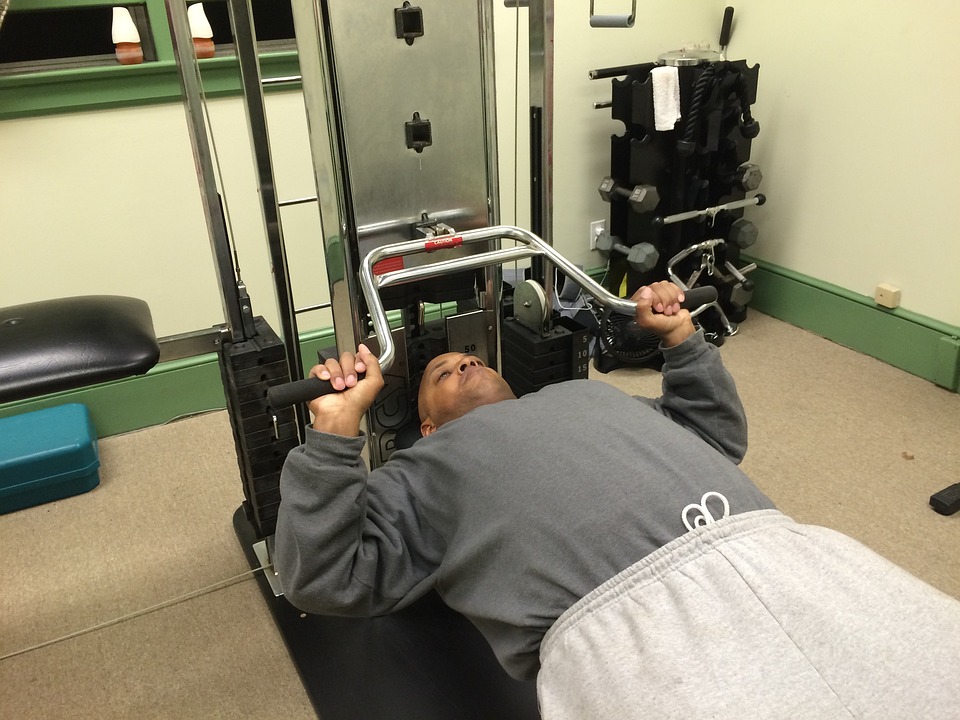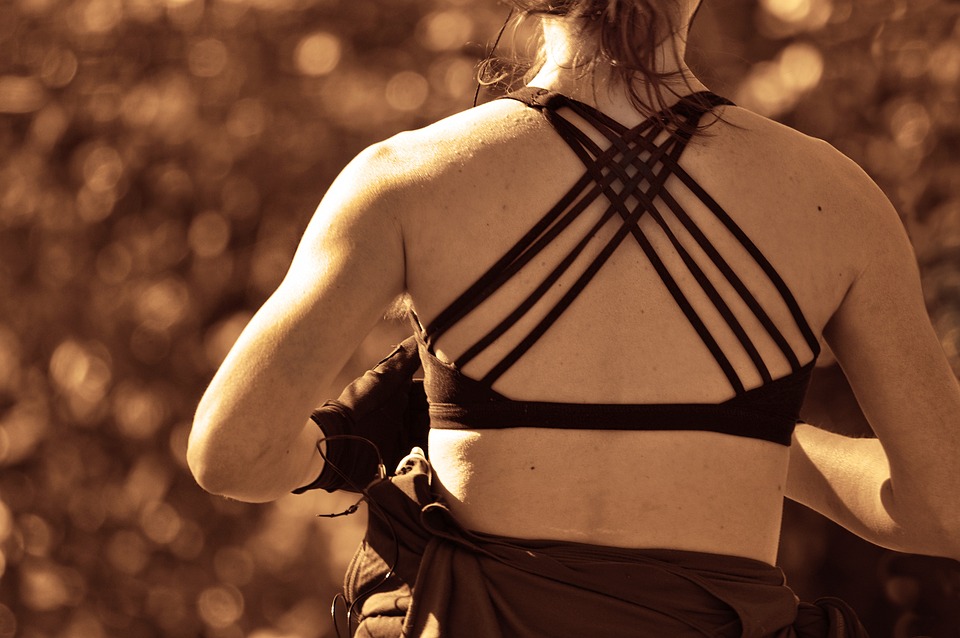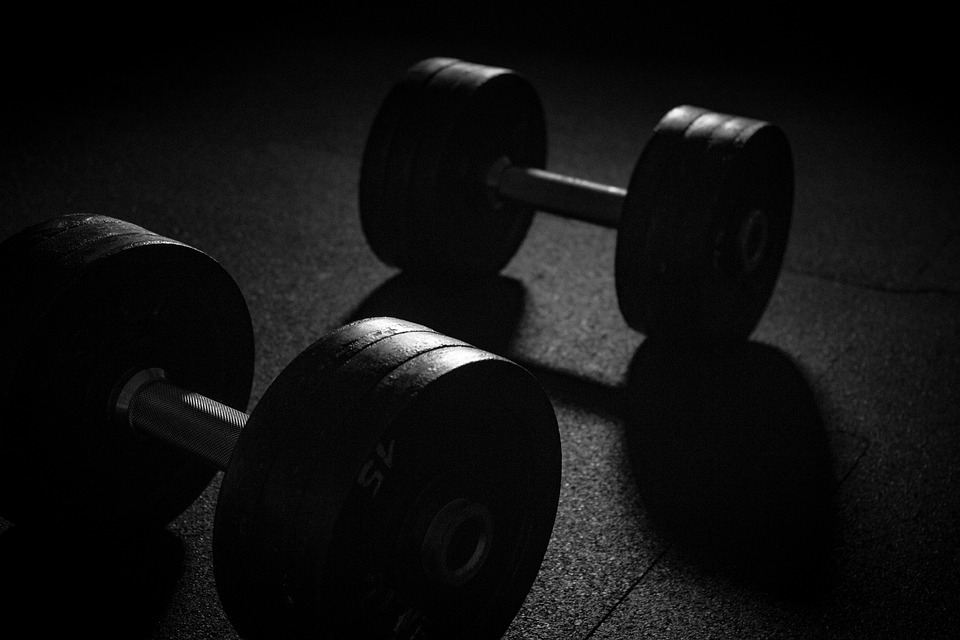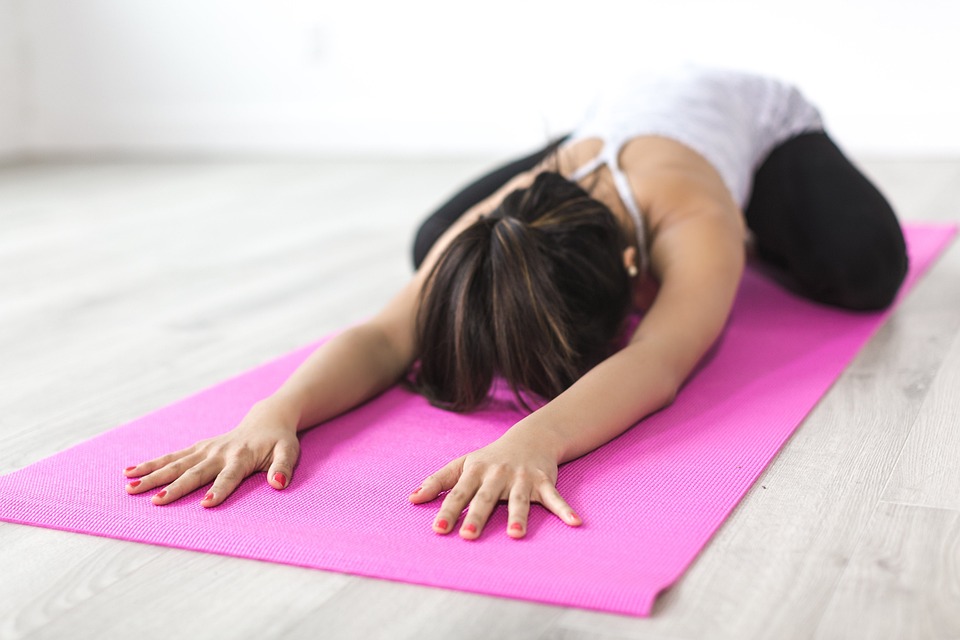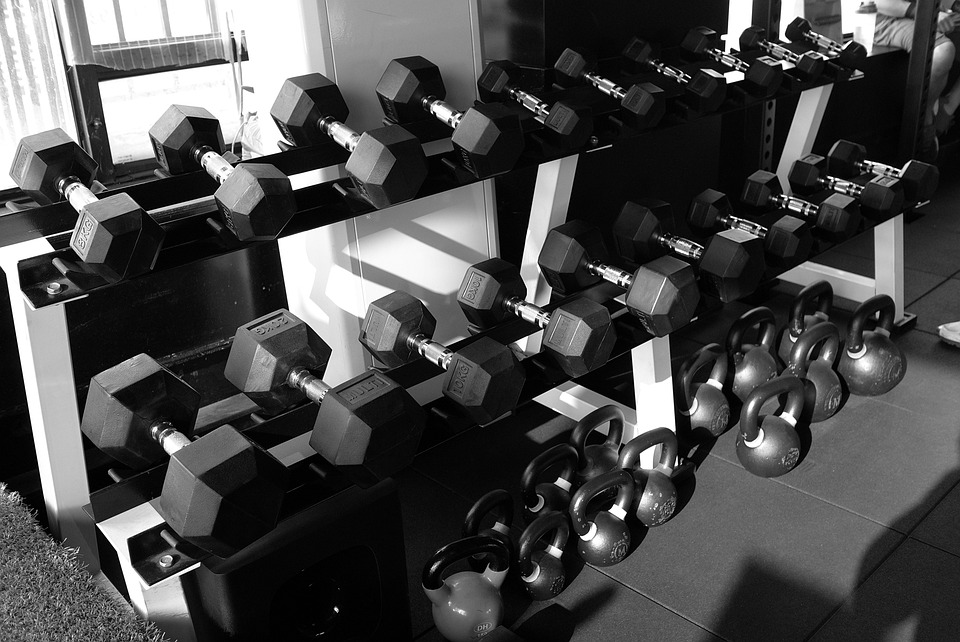
This exercise is great for targeting your large back muscle, as well as improving the function of your shoulder joint. One of the most effective back exercises is very simple and easy to do.
How to Do the Single-Arm Dumbbell Row
There are different versions of the single-arm row that target different muscles by using different arm positions and paths of motion. The most basic single-arm row technique will focus on the lat muscle.
Step 1 — Support Yourself on a Flat Bench
Place your one hand and the same-side knee on a flat bench with a dumbbell in between them. Your back should remain flat, and your shoulder blades should be pulled down and towards the back pocket of your pants. Maintain a neutral position for your head and neck, neither tilted up towards the ceiling nor down towards the ground. You can look at the ground in front of the bench.
Pick up the dumbbell with your other hand. Keep your palm facing the bench and let the weight down to the ground without moving your shoulder. Your elbow should be in a relatively straight position, but not locked when stretched.
The dumbbell will pull your body down to one side, but engage your core muscles to keep your hips level, maintaining a straight line from your hips to your neck.
Step 2 — Lift the Weight Towards Your Hip
To perform this exercise, bend your elbow and slide the weight towards your hip on the same side. Your palm should face the bench and your body should be neutral while you maintain a hand position. To engage the lat muscle as much as possible, keep your elbow close to your body.
Place your hand so that it is in line with your forearm and directly beneath your elbow. Keep your forearm in a position near your ribs and the weight almost touching your hip.
When pulling the weight up, they should not over-rotate their shoulders or twist their trunk. Don’t use jerky movements or try to heave your body to generate momentum.
Step 3 — Lower to the Stretched Position
Slowly lower the weight back to the starting point by reversing the direction. Lift the weight in a smooth arc away from your hip, keeping your arm nearly straight, with the weight directly under your shoulder.
Keep your shoulders in place as you lower the weight. To avoid injury, keep your shoulder locked into your shoulder girdle and pulled away from the ear. Do not shrug your shoulder up towards your ear or towards the ceiling.
Single-Arm Dumbbell Row Mistakes to Avoid
The biggest problems people have when doing single-arm rows usually have to do with not keeping the right position for their torso, shoulder, or arm. If you want to avoid issues, pay attention to your body and follow simple technique instructions.
Sagging Lower Back
When you lose engagement in your core muscles, your lower back can start to sag down toward the bench. If you slouch, it can cause strain on your vertebrae and lead to back pain or even injuries.
Try this instead: Think about lengthening your spine from your tailbone to your neck. Keep your abs tense. Do not rotate your hips as this can cause your lower back to become misaligned.
Curving the Spine Upward
If a spine is too stiff, it doesn’t have the ability to properly absorb the force of impact. A spine that is too stiff cannot absorb the force of impact properly. Keep your torso neither rounded nor excessively curved to maintain your joints aligned for optimal power output and muscle recruitment.
If you lose the neutral spine position and curve your back too much, you won’t be able to move your shoulder as much as you could otherwise. This will make the exercise less effective and can injure the shoulder joint.
To avoid injury, think of keeping your upper body flat with strong abs and stable, stable hips.
Dropping Out of the Shoulder Joint
The shoulder placement can be lost easily when the weight pulls the arm down during the eccentric portion of the exercise.
If your shoulders drop and your shoulder blades come forward, you’re at risk for shoulder pain or injury.
When doing this exercise, make sure to keep your shoulder blade pressed toward your back pocket. This is especially important when lowering the weight into the stretched position.
Benefits of the Single-Arm Dumbbell Row
Doing a single-arm row is a great way to get bigger and stronger in your back, shoulders, and arms.
The move works the majority of muscles in the upper body, making it ideal for those wanting to increase their muscular size or strength.
Training for a V-Taper Physique
The single-arm row is an effective exercise for building muscular size in the shoulders, upper back, and lats. This exercise can create an ideal v-taper, or an inverted triangle, physique. This gives the appearance of an athletic, well-developed body.
Training for Strength
If you have strong back muscles, you will be able to better support the weight during heavy bench presses and overhead presses, as well as many other exercises.
Improved Shoulder Health
This exercise is good for your upper back muscles and shoulders.
Muscles Worked by Single-Arm Dumbbell Row
The single-arm row is a good upper-body exercise because it uses several muscles in one movement.
Many compound exercises, like this one, are efficient for a variety of workout programs.
Latissimus Dorsi
The latissimus dorsi muscle, also known as the “lat,” is the primary muscle recruited during single-arm rows. The lats are two large muscles located on either side of the spine in the upper back. These muscles are responsible for extending and rotating the arms, as well as stabilizing the shoulder blades. The primary function of the biceps brachii is to draw the upper arm towards the centerline of the body.
Upper Back
The upper back has several smaller muscles that run across the shoulder blades, including the rhomboids, rear deltoids (shoulders), and teres major and minor. The muscles have similar roles in moving and stabilizing the shoulder blade.
Biceps Brachii
The biceps muscle is located on the front part of the upper arm and is responsible for bending and flexing the elbow. They are not recruited as the primary movers during the row but are recruited secondarily.
4 Dumbbell Lat Exercises To Build A Monster Wide Back
1. The Dumbbell Bent Over Row
The dumbbells don’t have the advantage of making you lift as much weight as you normally would with a barbell, but they don’t have the disadvantage of locking your wrist into place. You could start with your palms facing in, and at the top of the movement turn them so they face forward.
Where you start and finish with your palms is going to be up to you. You can start with your palms facing up or down, whichever is more comfortable for you. The position that works best for you may vary, so it’s advised that you experiment with different positions until you find what works best for you. Exercising with dumbbells should definitely be on your list of lat exercises.
Items Needed: 2 Dumbbells.
Cue 1: Take a dumbbell in each hand and hinge at the waist with your feet set shoulder-width apart.
Get into a squat position with the dumbbells in front of your shins and your palms facing back. Keep your back flat and bend your knees a little to avoid putting stress on your joints.
To get the most out of this exercise, you should retract your shoulder blades by pulling them down. This will help to activate the muscles in your back, and you’ll have a better connection between your mind and your muscles. Tighten your core and squeeze your back.
Cue 4: Smoothly pull the dumbbells to your hips or until your arms are bent at a 90-degree angle, and rotate your palms to face each other at the top of the movement. Grip the weight and squeeze it tightly for a moment before slowly lowering it back to the starting position.
At the end of the movement, extend your shoulders to create the illusion of being hunched over. This will help to engage more upper back muscles. That’s one That’s two That’s three Cue: That’s one That’s two That’s three
2. Chest-Supported Dumbbell Row
The advantage of this exercise over the Chest Supported T-Bar Row is that it is not a single-plane movement. This is a great lat exercise with dumbbells that you will wonder why it hasn’t been on your list before.
I’ll show you two ways to perform this movement and you can decide which one you want to do. If you’re going to increase the weight you’re lifting, make sure to put something on the top of the bench to cushion it. Otherwise, it can become uncomfortable in your rib cage.
For example, Body-Solid makes a good, inexpensive one. Dumbbells In order to complete this workout, you will need an incline bench set at a 45 to a 60-degree angle, dumbbells, and an example of a good, inexpensive incline bench would be the Body-Solid model. You’ll also need one pair of dumbbells.
Cue 1: (Option 1) Turn a high-incline bench around so that you are behind it. Place a soft pad on top of the bench for comfort. Place a dumbbell in each hand and lean your upper body against the pad.
Straddle an incline bench with a weight in hand, and walk up the bench until you are comfortably resting face-forward at the top.
Position your hands so that your palms are facing you at the start of the movement. Pull your shoulder blades down; this will help to engage the Lat muscles and improve your mind-muscle connection. Tighten your core and squeeze your Lats.
Bend your arms at a 90-degree angle while holding the dumbbells close to your hips. As you reach the top of the movement, rotate your palms so they are facing each other. Pinch the weight together with your fingers and then let go so it goes back to the starting position. If you raise the weight higher than hip height, you will use your Rear Delts more.
At the end of the movement, bring your shoulders forward so it looks as if you are hunching over. This will help to engage more upper back muscles. Repeat all of the cues as you go through each repetition.
3. Decline db Pullovers
The advantage of using a decline pullover machine instead of a flat dumbbell pullover is that the decline machine puts more stress on the Lat muscle fibers, resulting in a better workout.
You will need a decline bench or a flat bench that is resting on a platform, as well as one dumbbell to do this exercise.
Lay back on your decline bench setup and turn the dumbbell on its head. Slide your palms under the top of the dumbbell and lift it over your chest. To ensure your biceps are facing you, turn your elbows in.
While keeping your arms straight, slowly lower the dumbbell to a comfortable position over your head.
Before you bring the dumbbell back up to the overhead position, make sure to pull your shoulder blades back.
4. Seated Dumbbell Deadlifts
Dumbbell Lat exercises are taken to a new level with this movement. If you have never done the Seated Dumbbell Deadlift before, you are in for an experience. This exercise is performed in a seated position, which helps you focus on activating the muscles of your back, rather than just lifting the weight from one point to another. Follow the cues and do this exercise regularly, and your Lats will thank you.
Doing these near the beginning of your session will help to prevent the gas tank from becoming empty and the workout battery from being drained.
In order to complete this workout, you will need two dumbbells, a flat bench, and a block or platform. If you are going heavy, wrist straps are advised.
If you have long arms or you want to extend the range of motion, place a block or platform under the seated end of the bench.
Sit at the edge of a bench, with your feet flat on the ground and your knees at a right angle to your ankles. Place a dumbbell on each foot, with one end on the outer side.
Cue 2: With palms facing each other, lean forward so your chest is almost touching your thighs, and grip the dumbbells making sure that your back remains flat. Raise your dumbbells a few inches off the ground, and squeeze your shoulder blades together as hard as you can. This will engage your Lats.
Cue 3: As you slowly pull yourself up, you should feel the stress in your latissimus dorsi muscles from retracting your shoulders. Stand up straight while holding the dumbbells, then lower them to the floor. Place dumbbells on the outer side of each foot to engage more of the upper back when pulling up.
Who Should Do the Single-Arm Dumbbell Row
Lifters Training for Muscle Size
The single-arm row is a popular bodybuilding move because it allows you to focus on one side of the body at a time. This move can help you build symmetrical muscles.
Beginning Lifters
The support of the bench will help the person to focus on their form. Training multiple muscles at once is an excellent way to increase back strength. The single-arm row is a foundational exercise that helps to build general strength.
Frequent Sitters
If you work at a desk, spend a lot of time looking at a computer screen, or find that you are starting to get a forward roll in your upper back, the single-arm row can help to counteract alignment issues and postural problems by strengthening the muscles in your upper back.

